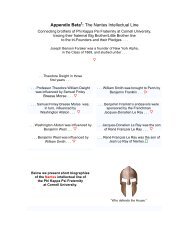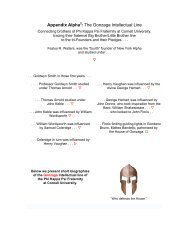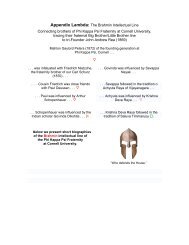Gondar - Phi Kappa Psi
Gondar - Phi Kappa Psi
Gondar - Phi Kappa Psi
Create successful ePaper yourself
Turn your PDF publications into a flip-book with our unique Google optimized e-Paper software.
Indies, the chief see of the Portuguese dominions in the East; metropolitan to the<br />
province of Goa, which comprised as suffragans the sees of Cochin, Mylapore,<br />
and Damão (or Damaun) in India, Macao in China, and Mozambique in East<br />
Africa. Mozambique was the gateway to Ethiopia.<br />
The archbishop, who resided at Panjim, or New Goa, had the honorary<br />
titles of Primate of the East and (from 1886) Patriarch of the East Indies. He<br />
enjoyed the privilege of presiding over all national councils of the East Indies,<br />
which were originally be held at Goa (Concordat of 1886 between the Holy See<br />
and Portugal, art. 2). The Patronage of the see and of its suffragans belonged to<br />
the Crown of Portugal.<br />
The history of the Portuguese conquests in India dates from the arrival of<br />
Vasco da Gama in 1498, followed by the acquisition of Cranganore in 1500,<br />
Cochin in 1506, Goa in 1510, Chaul in 1512, Calicut in 1513, Damao in 1531,<br />
Bombay, Salsette, and Bassein in 1534, Diu in 1535, etc.<br />
From the year 1500, missionaries of the different orders (Franciscans,<br />
Dominicans, Jesuits, Augustinians, etc.) flocked out with the conquerors, and<br />
began at once to build churches along the coast districts wherever the<br />
Portuguese power made itself felt. In 1534 was created an episcopal see<br />
suffragan to Funchal in the Madeiras, with a jurisdiction extending potentially<br />
over all past and future conquests from the Cape of Good Hope to China. In<br />
1557 it was made an independent archbishopric, and its first suffragan sees were<br />
erected at Cochin and Malacca. In 1576 the suffragan was added; and in 1588,<br />
that of Funai in Japan. In 1600 another suffragan see was erected at Angamale<br />
(transferred to Craganore in 1605) for the sake of the newly-united Thomas<br />
Christians; while, in 1606 a sixth suffragan see was established at San Thome,<br />
Mylapore, near the modern Madras. In 1612 the prelacy of Mozambique was<br />
added, and in 1690 two other sees at Peking and Nanking in China. By the Bulls<br />
establishing these sees the right of nomination was conferred in perpetuity on the<br />
King of Portugal, under the titles of foundation and endowment.<br />
The limits between the various sees of India were defined by a papal Bull<br />
in 1616. The suffragan sees comprised roughly the south of the peninsula and<br />
the east coast, as far as Burma inclusive, the rest of India remaining potentially<br />
under the jurisdiction of the archdiocese and this potential jurisdiction was the<br />
actually exercised even outside Portuguese dominions wherever the Faith was<br />
extended by Portuguese missionaries. Missionary work progressed on a large<br />
scale and with great success along the western coasts, chiefly at Chaul,<br />
Bombay, Salsette, Bassein, Damao, and Diu; and on the eastern coasts at San<br />
Thome of Mylapore, and as far as Bengal etc. In the southern districts the Jesuit<br />
mission in Madura was the most famous. It extended to the Kistna river, with a<br />
number of outlaying stations beyond it. The mission of Cochin, on the Malabar<br />
Coast, was also one of the most fruitful. Several missions were also established<br />
in the interior northwardds, e.g., that of Agra and Lahore in 1570 and that of Tibet<br />
in 1624. Still, even with these efforts, the greater part even of the coast line was






